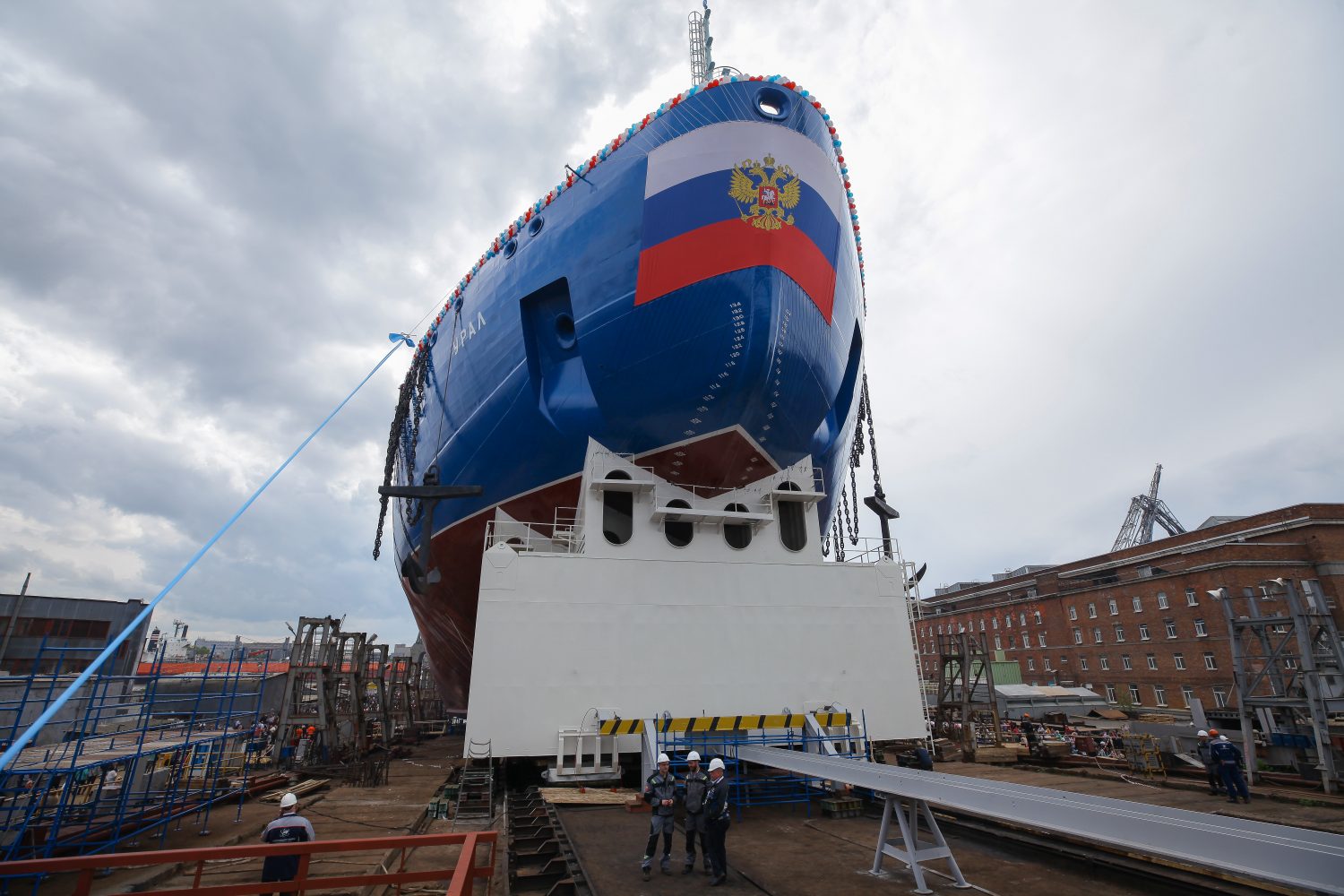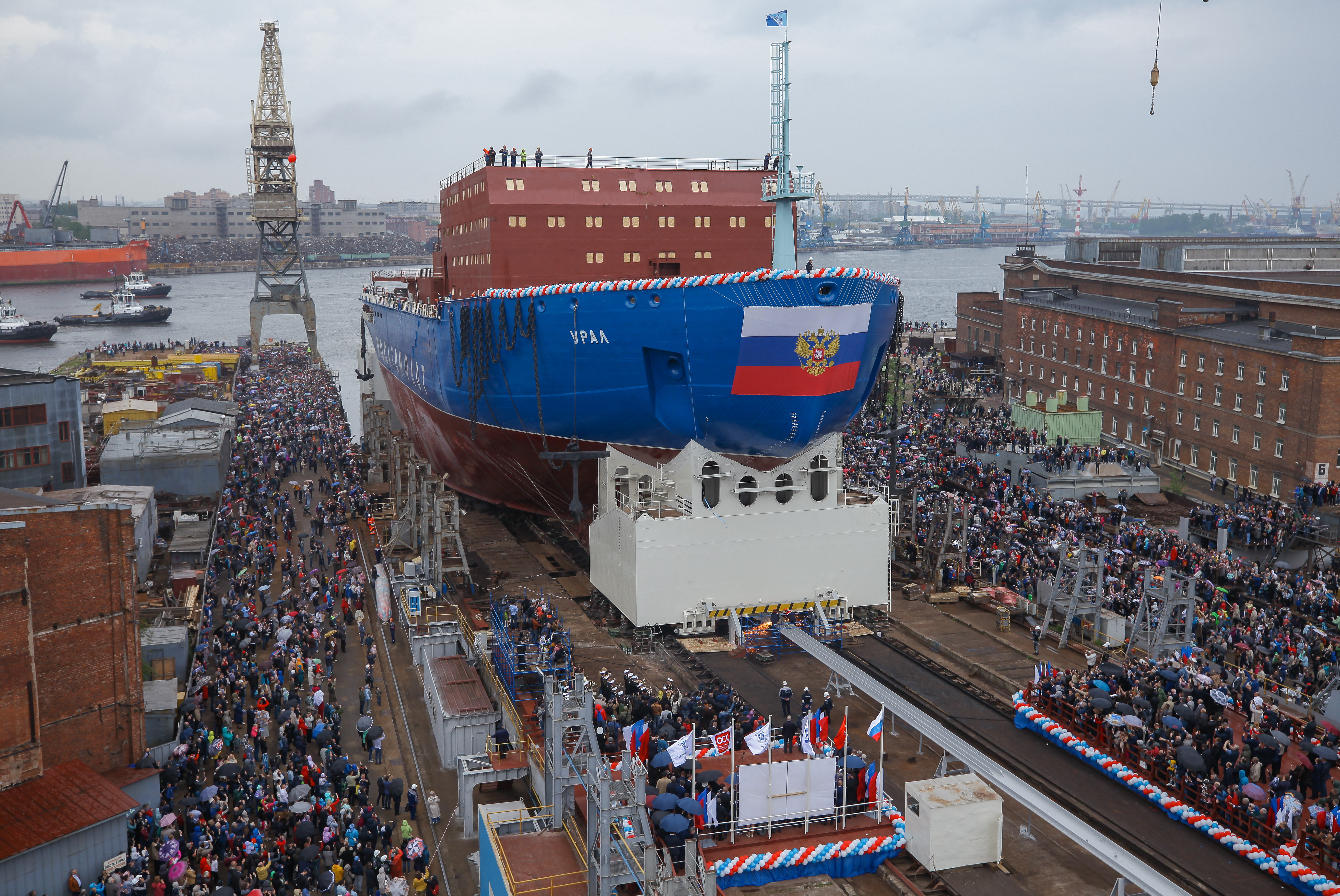
Third Afloat
back to contentsThe float out is a serious milestone in shipbuilding. During the launching, the ship’s hull is transferred from the slipway into the water for the subsequent fitting-out. Shipbuilders fairly see the ship launching as a celebratory occasion. Hundreds gathered to watch how the nuclear-powered icebreaker Ural was floating out.
After the chief engineer gave a command to launch the ship, the steel structure keeping 19,000 metric tons of the vessel’s hull was cut to let it go. Ural slid into the waters of the Neva River met with loud applause of the crowd. At the time of launching this icebreaker was 7,000 tons heavier than its Project 22220 forerunner. The explanation is simple: Ural had two RITM-200 reactor units already installed and was almost completely fitted out with electric propulsion system, which includes electric propulsion motors, generators, switchgear, etc. Previously reactors and electric propulsion systems had been installed when the ship was already afloat. In the case of Ural, shipbuilders decided to change the sequence of operations to reduce the time and cost of construction without compromising on safety. The commissioning is scheduled for August 2022.
Arktika (Arctic) and Sibir (Siberia), the first two Project 22220 icebreakers, are already afloat and will be put into operation in 2020 and 2021 respectively. At present, Arktika’s reactor is being loaded with nuclear fuel.
All nuclear icebreakers are being built at the Baltic Shipyard under the contract with Rosatomflot, a Rosatom Group operator of the nuclear fleet. According to Rosatom Director General Alexey Likhachev contracts for the construction of two more Project 22220 icebreakers will be signed by the end of this summer. Preparations are now underway to tender out the contracts. The total price will be around RUB 100 billion (USD 1.5 billion). For the very first time nuclear icebreakers’ construction will get a mixed funding. The federal government will provide RUB 45 billion (USD 700 million), with the rest (RUB 55 billion or USD 845 million) to come from Rosatom and commercial banks. The Russian government financed construction of the previous icebreakers entirely on its own.
“Our nuclear fleet is what the country is proud of. I am pleased to see that this is where we are not losing ground but growing and building new ships,” Elvira Nabiullina, Governor of the Bank of Russia and a “godmother” of the icebreaker, said at the ceremony.
“It is this new generation of icebreakers to which we pin our hope of developing the Northern Sea Route. This is an all-new ship,” Russian Vice Prime Minister Yuri Borisov said.
“Serial construction of these new-generation icebreakers is a key to successful development of the Arctic region,” Sergey Kirienko, First Deputy Chief of Staff of the Presidential Administration of Russia, agreed with him.
Like other Project 22220 icebreakers, Ural has two RITM-200 reactor units with a thermal power of 175 MW each. The ship was designed at the Aisberg Design Bureau in 2009. It allows for the operation both in deep waters of Arctic seas and estuaries of polar rivers. The icebreaker will operate in the Western part of the Russian Arctic (Barents, Pechora and Kara Seas) and shallow waters of the Yenisei River and the Gulf of Ob.
According to the Russian Academy of Sciences, the Arctic accumulates a large portion of the global gold, oil and gas reserves estimated at around USD 30 trillion. In December 2018, Rosatom has been appointed as an operator of the infrastructure on the Northern Sea Route, which is the shortest way between Northern Europe and Eastern Asia.
Earlier, Rosatom’s Director General Alexey Likhachev announced plans to increase freight traffic on the Northern Sea Route to 92.6 million tons by 2024.
Year-round navigation here will be guaranteed when the first icebreaker of the Leader series is commissioned. This ship will be two times more powerful than those now under construction and capable of breaking 4-meter thick ice. Rosatomflot is waiting for approval of the Zvezda Shipyard located in Russia’s Far East. The plans are to build three icebreakers of the Leader series. “These vessels will be used primarily on the eastern section of the Northern Sea Route to transport cargo to China, Japan and South Korea,” Alexey Likhachev said. The first Leader icebreaker is expected to be commissioned in 2026–2027.
By 2035, Russia will have at least nine nuclear icebreakers. For the time being, Rosatomflot has four icebreakers and a lighter. The service life of their nuclear propulsion units can be extended till at least 2025.
Key specifications of the Ural icebreaker:
Shaft power: 60 MW
Speed: 22 knots (in open water)
Length: 173.3 m
Width: 34 m
Height: 52 m
Draft: 10.5 m / 8.65 m
Maximum ice thickness: 2.8 m
Full displacement: 33,540 tons
Estimated service life: 40 years




